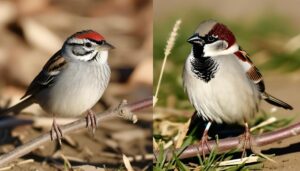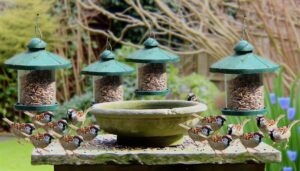Identifying Common Lark Sparrows in Southern California
Lark Sparrows are relatively common in Southern California, particularly along the coast and in rural farmlands. They primarily inhabit grasslands and scrub, as well as human-altered landscapes such as vineyards.
Their numbers fluctuate seasonally and are influenced by factors such as habitat loss, predation, and pesticide exposure. These sparrows, recognizable by their distinct markings and melodious song, play a key role in spreading plant species and controlling pests.
For further insights on their distribution, specific habitats, and contribution to local ecosystems, stay tuned.

Key Takeaways
- Lark Sparrows are common in coastal regions, which include parts of Southern California.
- They are abundant in grasslands, scrublands, and rural farmlands, common habitats in Southern California.
- These birds have high adaptability, utilizing human-altered landscapes like vineyards, orchards, and roadsides.
- Their numbers increase in spring and early summer during the breeding season.
- Despite being common, their numbers are affected by habitat loss, predation, and pesticide exposure.
Understanding Lark Sparrows
Diving into the world of ornithology, one quickly uncovers the unique intricacies of the Lark Sparrow, a native bird species of Southern California, renowned for its distinctive markings and melodious song.
The Lark Sparrow (Chondestes grammacus) is an eye-catching species, with its bold, chestnut-colored cheek patches and intricate streaks on its breast. Its song, a complex mix of melodious whistles and trills, is as unique as its plumage.
They're mainly ground feeders, their diet primarily consisting of seeds and insects. Lark Sparrows prefer open habitats and are often found in grasslands, scrublands, and farmlands.
Their nests are typically built on the ground, tucked away in the shelter of taller vegetation, revealing their preference for a secure environment.
Population Distribution in Southern California
Lark Sparrows flourish across Southern California, their population strategically spread in areas providing the ideal mixture of open habitats and taller vegetation for nesting. They're not randomly distributed; instead, their locations reveal a pattern that aligns with specific environmental conditions.
- Coastal Regions: Lark Sparrows are common in coastal regions where the climate is moderate, and a variety of flora flourishes.
- Grasslands and Scrublands: These birds have been observed in considerable numbers in grasslands and scrublands, which offer ample ground cover.
- Rural Farmlands: Curiously, rural farmlands also witness a high presence of Lark Sparrows due to the abundance of seeds and insects.
This distribution suggests a highly adaptable species, capable of thriving under diverse conditions while maintaining a steady population, showcasing their resilience in Southern California's ecosystem.
Typical Habitats of Lark Sparrows
When it comes to their habitats, Lark Sparrows display an impressive adaptability, comfortably making their homes in a diverse range of environments from coastal regions to grasslands, scrublands, and even rural farmlands. They've developed a particular knack for utilizing human-altered landscapes, often found nesting in vineyards, orchards, and along roadsides.
| Habitat Type | Details |
|---|---|
| Coastal Regions | Lark Sparrows thrive in these areas due to the availability of insects and seeds, their primary food sources. |
| Grasslands/Scrublands | These sparrows prefer open areas with scattered shrubs for nesting and feeding. |
| Rural Farmlands | They exploit man-made structures like fence lines for nesting, often found in cultivated fields and pastures. |
Detailed analysis of these habitats gives us insights into the resourcefulness and adaptability of Lark Sparrows. Understanding their preferred habitats aids in their conservation.
Factors Affecting Lark Sparrow Numbers
While understanding their preferred habitats is an important aspect of Lark Sparrow conservation, it's equally significant to take into account the various factors that are impacting their population numbers.
Three key factors are:
- Habitat loss: Rapid urban development and agricultural expansion in Southern California have resulted in significant loss and fragmentation of the Lark Sparrow's natural habitats, reducing their numbers.
- Predation: Predators, both native and introduced, pose a significant threat to Lark Sparrow populations. Domestic cats, in particular, are known to be a major predator of these birds.
- Pesticide exposure: Pesticides used in agriculture and residential areas can indirectly affect Lark Sparrows by reducing their insect food sources and directly by causing toxicity.
Each factor contributes to the overall decline, making conservation efforts a complex task requiring a multifaceted approach.
Seasonal Variations in Population
Seasonal rhythms play a crucial role in the fluctuating population numbers of Lark Sparrows in Southern California. Their numbers tend to swell during the spring and early summer, corresponding with their breeding season. During this time, the abundance of food resources, such as insects and seeds, supports the growth and survival of offspring.
As the seasons shift into fall and winter, the population numbers decline. This decline is mainly due to the migration of sparrows to warmer regions, as well as a decrease in food supplies. Surprisingly, this seasonal ebb and flow isn't always predictable, with some years witnessing unexpectedly high or low populations.
Hence, continual monitoring and data collection are essential for understanding these seasonal variations in Lark Sparrow populations.
Impact of Urbanization on Lark Sparrows
Urbanization's relentless march in Southern California has greatly impacted the Lark Sparrow's habitat, leading to dramatic changes in their population dynamics and survival strategies. The sparrows, typically thriving in grasslands and savannas, now face an environment increasingly dominated by human infrastructure and activity.
Loss of Habitat:
Construction projects replace open spaces with concrete jungles, leaving little room for the birds to nest and forage.
Food Scarcity:
With natural vegetation disappearing, the sparrows struggle to find their staple diet of seeds and insects.
Increased Predation:
Urbanization attracts predators like cats and rats, exacerbating the sparrows' survival challenges.
These factors combine to create a hostile environment for the Lark Sparrows, leading to their declining population in Southern California.
Conservation Efforts for Lark Sparrows
Efforts are being ramped up to conserve the Lark Sparrow population in Southern California, tackling the challenges of habitat loss, food scarcity, and increased predation brought on by urbanization.
Conservationists are employing a multipronged strategy that includes habitat restoration, nest protection, and studying the birds' behaviors to predict and mitigate potential threats. They're reinstating native plants which serve as both shelter and food sources, while simultaneously launching initiatives to control predators. Additionally, the establishment of designated protected areas restricts human interference.
In-depth research is being conducted to better understand the birds' dietary needs, mating habits, and migration patterns. This scientific approach aids in crafting effective conservation strategies, ensuring the Lark Sparrow's survival in Southern California.
Lark Sparrows and Local Ecosystems
In an examination of the Lark Sparrow's habitat preferences, it becomes apparent that these birds display flexibility, adapting to a diverse range of environments within Southern California.
Their presence, however, extends beyond mere habitation, influencing local biodiversity through their role in the insect population control and seed dispersal.
Consequently, the Lark Sparrow isn't just a component, but an active participant and crucial player in the local ecosystems it inhabits.
Sparrow Habitat Preferences
Lark Sparrows, a common sight in Southern California's local ecosystems, display a distinct preference for open, grassy habitats peppered with scattered shrubs.
These birds often choose areas with a mix of grasses and forbs, which provide ample food resources, and shrubs, which offer protection from predators.
They're also partial to habitats with bare soil or sparse vegetation, as these conditions facilitate ground-feeding and nesting.
Finally, they favor landscapes with varying levels of vegetation height, taking advantage of both low-growing plants for foraging and taller shrubs for nesting.
These specific habitat preferences reflect the Lark Sparrow's adaptability to Southern California's Mediterranean climate and its unique ecosystem, making them a quintessential part of the region's avian biodiversity.
Impact on Biodiversity
Southern California's biodiversity greatly benefits from the presence of Lark Sparrows. These birds contribute to seed dispersal and pest control within their preferred habitats. By feeding on various seeds, the Lark Sparrows indirectly participate in spreading plant species across their habitats, which promotes plant diversity.
In addition, their diet includes a wide range of insects, acting as a natural form of pest control. This balance aids in maintaining the health and diversity of the ecosystems they inhabit. However, it's also essential to note that the Lark Sparrow's role in biodiversity is contingent upon their population size and distribution.
If their numbers decline due to habitat loss or other factors, these valuable ecosystem services may diminish, detrimentally impacting the overall biodiversity.
Observing Lark Sparrows: Tips and Tricks
One might find observing Lark Sparrows an intriguing activity, particularly when equipped with the right knowledge and tools. These birds can be elusive, but with patience and know-how, one can spot them in Southern California's diverse habitats.
Here are three tips to increase your chances of a successful sighting:
- Timing: Lark Sparrows are most active in the early morning and late afternoon. These 'crepuscular' periods provide the best opportunities for observation.
- Location: Look for them in open, grassy areas with scattered trees. They're ground-nesting birds, so keep your eyes peeled near the ground.
- Equipment: A good pair of binoculars is essential. Look for a high-quality pair with strong magnification to spot these birds from a distance.
Conclusion
Simply put, Lark Sparrows are fairly common in Southern California, thriving in its diverse habitats.
However, urbanization is no walk in the park for these birds, presenting challenges to their survival.
Conservation efforts are essential to sustain their numbers and guarantee they continue to enhance the local ecosystems.
Keep a lookout for these fascinating birds and value their understated yet important role in upholding ecological balance.






